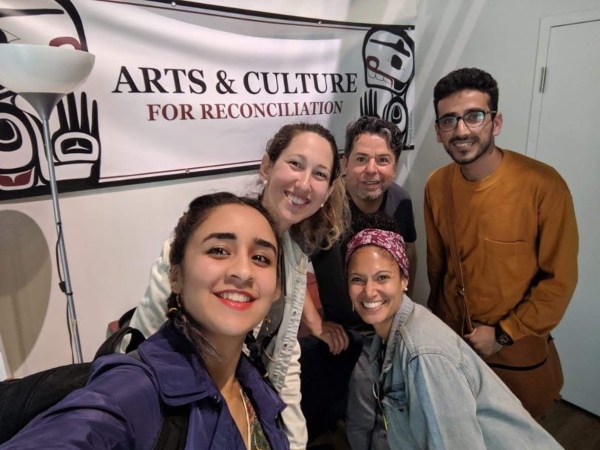“My Home is a Suitcase” is a play by Rzgar Hama about individuals who sought new lives as immigrants. It is based out of Vancouver, British Columbia, Canada. These are real stories. The next few interviews will be from some of the individual readers of their stories of beginning new lives in Canadian society. Hama is known for several plays, including “Soldierland” with some professional commentary by Dr. Marvin Westwood and Dr. George Belliveau of The University of British Columbia in “Dr. Marvin Westwood & Dr. George Belliveau on SOLDIERLAND a play Written and Directed by Rzgar Hama.” Here I speak with Hila on “My Home is a Suitcase.”

Scott Douglas Jacobsen: So, the play is “My Home is a Suitcase.” The playwright is Rzgar Hama Rashed. In another way, it is merely people telling their stories who are partial playwrights in a way because they are providing their narratives, their life stories. In terms of your involved with “My Home is a Suitcase,” Hila, what is the story with becoming involved with Rzgar, with Sky Theatre Group? Was this floating around the internet or knowing others within its social and professional orbit?
Hila Graf: A little bit of both, my background is in theatre, directing, and teaching. I moved to Vancouver 2 years ago. I consider myself an emerging theatre artist and educator, so I was looking for opportunities to become involved with an artistic project. Especially something in a community setting, since an important part of my training was on community-based theatre. I really love working with different groups, which aren’t necessarily professional, but rather they use theatre as an instrument to tell their stories.
I met Rzgar through the research-based theatre collaborative at UBC, Then I saw a post of “My Home is a Suitcase” on LinkedIn, it was the first time I saw something on LinkedIn that was appealing to me and I got excited about this project. I reached out to Rzgar and we talked about the project. He asked if I wanted to be one of the participants to tell my story.
But because of my background in directing, I preferred to be part of the overall process and learn from Rzgar, in terms of how he works on the project from the beginning, from a director’s perspective. It has turned out to be a really beautiful learning experience for me.
Jacobsen: Now, when you’re looking at some of these stories and comparing it to some of the standard play repertoire that you’re teaching or see in some of the Downtown Vancouver area in the art scene, what are the comparisons and contrasts there? Either that are pieces around or the differences in content tone, where one produces a play with real narratives as opposed to ones that are invented and have that kind of truth infused into the parts that are imaginary.
Graf: The whole method of community theatre and devised theatre, is something that has been used around the world for many years. In Vancouver, it is still a relatively new concept. Traditional theatre usually focuses on producing plays that are based on an existing script. Then the cast and creative team come together and they work on bringing the script to from paper to stage. Even in community settings, sometimes, the choice will be, “Let’s all do Shakespeare together” for example, so the community will explore their identity or story through the lens of an existing play. It is an amazing method. But what is unique about “My Home is a Suitcase” is that it focuses on people’s true stories, so, what comes out is not filtered, the whole process is very, very personal for everyone involved. Basically, you’re asking people who don’t have a lot of writing experience in theatre context to write something based on their life experience. Often, the stories involve vulnerable experiences the participants had in their life.
And the goal of the project isn’t just artistic, it is c creating a community and empowering people as they are going through this journey of sharing their story, with the group and then with an audience.
Jacobsen: Were there any particular moments in the development of this project where individuals had to stop in the middle of telling their story because it was too hard?
Graf: I don’t remember people stopping, necessarily. But I do remember people debating which parts they should leave out of the piece, especially during the one-on-one sessions. It was three of us in the directing team, Rzgar as the director and Lennora and I as assistants, so at some point we split the group and each of us had one-on-one sessions with some of the participants. It was nice to get deep into the stories and hash out the exact part of the story the writers want to focus on. But because every person has a 20- to 40-year span of lifetime it is a challenging task when the goal is to have a 7-minute presentation, which was the goal of the first phase of the project.
When we did the one-on-one, I remember some people were deliberating whether they should include some parts of the story or not, and sometime they would decide to leave somethings out because that was too personal for them. It is a challenge, to try to be honest and share your truth and at the same time protect your privacy. It was very inspiring to witness that process.
So, the complete ownership of the story and how they want to present their story was of the participants. It is really, really important. Because in the end, they have not only written their story; they have also read it in front of an audience, which is a very courageous this to do.
Another part was how to approach the different information pieces coming into the room. People were sharing personal information, sometimes very traumatic. We had to figure out our group rules of when and how to ask questions about everyone’s stories, and when to leave it alone, so that each person will have the agency to share as much as they want. It was about making sure this was a safe space for everyone to explore and create.
Jacobsen: You are dealing with people who may not have much or any theatre experience. They are a self-selected group with putting out a call for refugees to come and tell their stories. What are the factors you’re taking into account in getting the narratives for those who may not have the theatre experience and may be the self-selected group with trauma stories in general?
Graf: That’s an interesting question. We worked with the group with the same tools we would use with professionals, but in a different way It’s the same tools that shape community theatre and professional theatre, and community theatre is a genre and an art form like many others, so it has its own style It is more authentic and intimate. It could be a little rough around the edges and that’s part of the beauty. We wouldn’t try to mask it. We would use different tools like voice work and body posture, breathing techniques, which everyone can do in order to support the cast to communicate their story in the best way possible.
We work with everybody to get comfortable in sharing their story in front of an audience. A lot of agency is given in terms of what the performers, feel comfortable with and what works for them. With this project we also want to show that anyone can perform and share their story, this is a part of being human –
we need water and food, and sleep, but also stories. We are always thirsty for stories. Even if we are not part of the professional world, as humans we understand storytelling, and we have a strong motivation to engage in storytelling – to share what we are doing and feeling and to learn about others. This goes beyond the professional performing arts community to every human.
It is inspiring to see how easy it is. It is something ingrained in each and every one of us. The only difference between the participants of My Home is a Suitcase and anyone else is that they have chosen to take the time and put their focus and energy on telling their story
I think that’s part of what is inspiring in that. These people have chosen to put that spotlight on themselves, on their history, and examine their own and life story and share it with others.
Jacobsen: What is the big takeaway from this project for you? Relative to a lot of Vancouver, these are stories about pain, dislocation, loss, and many times coming to a new place in triumph.
Graf: Some of the stories have traumatic components in them, but some of them are full of humour and full of the small intimate moments of life that we can all identify with. I think the important thing is people will be able to empathize with the people behind the stories and learn about the amazing diversity we have here in the community. The different stories of immigration are so different from one another and so unique
They are so specific and moving. The stories of resilience in the journeys people went through; the choices that they made in their lives. It is about choices in light of circumstances, which is something that I believe everyone can relate to. It is shedding some light on this part of our community, on immigrants and refugees, and making sure that all newcomers, immigrants and refugees are celebrated in the community
It is really tied to what we have been seeing in our society around the Black Lives Matter movement. Every person wants to be loved, wants to be celebrated, wants to have opportunities. I think My Home is a Suitcase piece is an excellent step in the way to make that possible.
Jacobsen: Hila, thank you so much.
Graf: Sure, thank you.

Photo by Blake Cheek on Unsplash
Image Credit: Soran Mardookhi, and Rzgar Hama/Sky Theatre Group.

